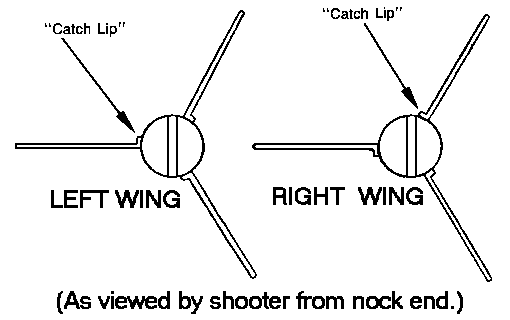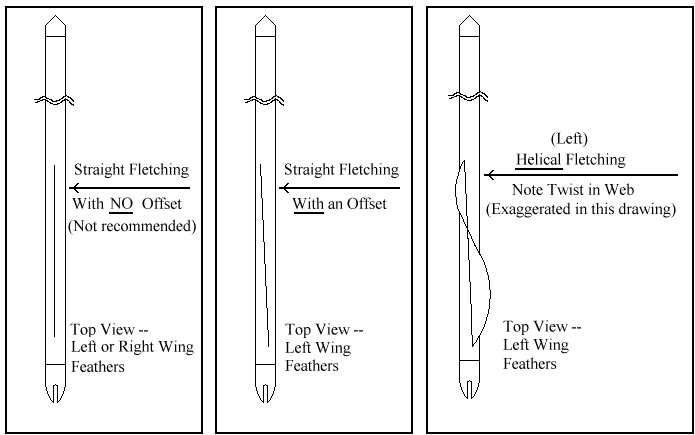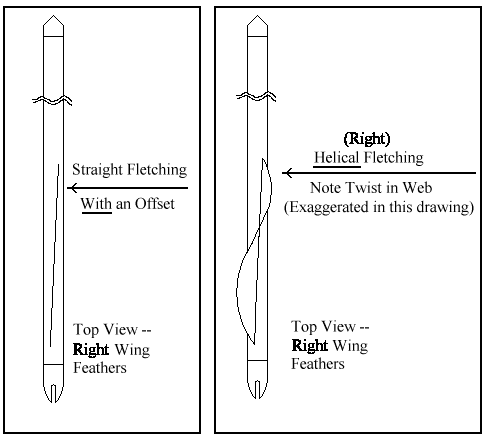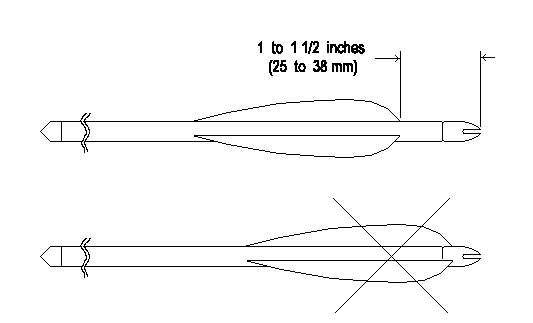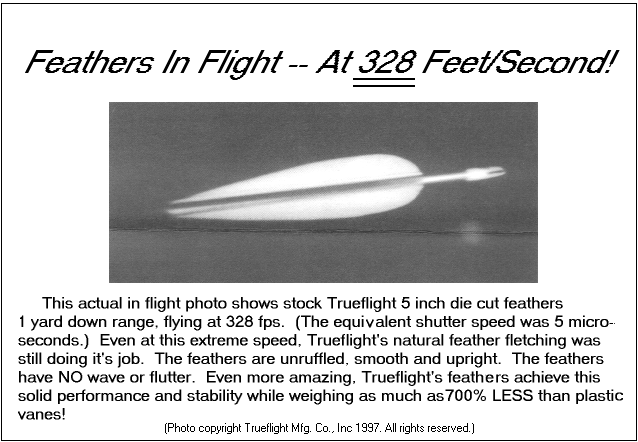Questions about choosing, and fletching Trueflight Feathers are answered in our Fletching Guide.Questions comparing feathers and plastic vanes are answered in Feathers Vs Plastic Vanes.
Are your products real feathers?
Yes. All of our feathers are domestic turkey feathers (Melegris Gallopavo).Where do you get these feathers?Our feathers are gathered at U.S. turkey processing plants. We are only able to use 1 to 2 feathers from each wing. All of these plants and our own plants are subject to regular USDA inspections.Does Trueflight Mfg. sell arrows?No. We have never sold completed arrows or bows. We are specialists in "missile guidance" only. (Hey, that sounds pretty high-tech!)I shoot an XXX bow, with YYY shafts. What size feathers should I use?There is a company with a similar sounding name which does sell arrows, but we have no connection with them.
In Archery, “one size DOESN’T fit all”. There are so many possible variations in equipment, shooting style, shooting conditions, etc., that ACTUAL TEST SHOOTING BY THE ACTUAL ARCHER is the only way of knowing for sure how well a particular setup will preform.What if I hunt in the rain - how can I protect the feathers?That being said, we can recommend general guidelines for a “starting point” for testing. For a modern compound bow, a 3 fletch of 4 inch long feathers will usually give good guidance with both field points and most broadheads. More traditional longbows and recurves will generally do very well with a 3 fletch of 5 inch long feathers.
Testing may show that it is possible to use slightly smaller feathers with good results, or that larger feathers for more stability are required. In any case, it is important that the fletching be offset, or helical to make sure the arrow rotates in flight. Keep in mind that ACCURATE flight and STRAIGHT PENETRATION of the arrow into the target are of vital importance. Without these, all other effort in shooting is wasted. It is much better to have too much guidance, than too little. If you will be shooting broadheads (either fixed or mechanical), by all means test shoot them before going hunting with them.
Excellent dry powder water proofing such as Bob Rightnour's "Fletch Dry" are now available. "Fletch Dry is easily applied to completed arrows, adds virtually no weight to the arrow, does not stiffen the web of the feather and does a super job of water proofing."Fletch Dry" treated feathers will shed water for days.. it's really amazing. You have to see it to believe it. (Contact: Rightnour Mfg., Box 107 Main St., Mingoville, PA. 16856)
If you don't have a waterproofing available, then a plastic "baggie" slipped over the fletching will keep the feathers dry indefinitely.
Can I shoot feathers through a Whisker Biscuit arrow rest?
Yes, indeed! Feather fletching works very well with a Whisker Biscuit rest. In fact, our Vice President and General Manager, Bob Link, took 3 Pope & Young whitetails in 5 years using feathers with a Whisker Biscuit!After many shots, some wear may be apparent on the edges of the feathers. This seems to have no effect on their performance. We usually wind up re-fletching our “practice arrows” about once a year... mainly for appearance sake.
I'm right handed, should I use right wing or left wing feathers?
You can successfully shoot either wing. An arrow does not rotate noticeably until it is well clear of the bow.Left wing feathers should be used to rotate the arrow counter clockwise, right wing clockwise (as viewed by the shooter).
How can I tell if my feathers are right or left wing?
First method: Look at the nock end of an arrow (as though it is about to be shot), and rotate it so that one fletching is on top of the shaft. If the "catch lip" is to the left of the web, it is a right wing feather. If the "catch lip" is to the right of the web, it is a left wing feather (see diagram).
Second method: Hold the forward end of a diecut (pointed end) or full length feather (large end) toward yourself. Look down from the top. Rotate the feather so that its web is horizontal and its natural curve droops the end pointed away from you downward ("shedding rain" as opposed to "catching rain"). If the web is to the right of the quill base, it is a right wing feather. If the web is to the left of the quill base, it is a left wing feather.
Should I use RIGHT wing with a RIGHT helical clamp, and LEFT wing with a LEFT helical clamp?
Yes. RIGHT wing for a RIGHT helical clamp. LEFT wing for a LEFT helical clamp.
Should I use straight, offset or helical fletching clamps?
We strongly recommend offset or helical fletching on all arrows.Offset or helical fletching causes the arrow to rotate in flight just like the rifling in a gun barrel causes bullet to rotate. This is extremely important. The rotation acts like a gyroscope to stabilize the arrow. This rotation also "averages out" any slight microscopic imperfections in the arrow.
This advantage was reportedly first noticed in smooth bore muskets, shooting round lead balls. The smooth bores were accurate to about 50 yards. However simply adding rifling to the barrel (or even angled scratches inside the barrel!) caused accuracy to improve enough so that the accurate range became 150 yards. This increase was apparent even when shooting the same round lead balls.
Helical fletching offers more stability than a simple offset and is therefore the first choice for any arrow tipped with a broadhead.
How far forward from the rear of the arrow should I place the feathers?
The rear of the feathers should be far enough forward to clear the shooters fingers or release mechanism when releasing the string. For finger shooters this is usually about 1 to 1 1/2 inches or 25 to 38 mm.Do "Round Back" (or "Parabolic") and "Shield Back" fly differently?The feathers should also be far enough forward so that their bases can be securely attached to the shaft, not the nock.
All else being equal, the further to the rear the feathers are, the more efficient the guidance. The feathers should not be any further forward than is necessary for clearance.
We haven't been able to detect any difference in the performance of round back or shield back. It appears that the only difference is one of appearance. Round back are more popular in the United States; shield back are more popular in Europe.Doesn't the web of the feather fold down to the shaft at high speeds?
NO WAY! We have lots of photos of feathers at speeds above 300 fps and the feathers look great! For example:
Are Natural Barred feathers available?
No. Natural Barred feathers (from darker "bronze turkeys") are no longer available in commercial quantities.Where can I find Craft Feathers for tying flys, costumes, etc.?We do think, however that our "Trueflight Barred" pattern is a pretty close substitute for "Natural Barred". Trueflight Barred are very similar in appearance to natural barred. (See products).
Craft Feathers can be obtained from:Why doesn't this web site have scrolling banners, music and fancy fonts?Crafty's Featherworks
P.O. Box 370, 480 Pat Ave.
Overton, NV 89040
702-397-8211 Fax: 702-397-2662We wanted this web site to run fast, to be convenient, and to be useful. We hope we are presenting good information in the most efficient way. We welcome any suggestions for additions and improvements.
Email us at: email@trueflightfeathers.com
Home - Feathers Vs Vanes - Fletching Guide - Products - Examples - Buying - Distributors - Flu-Flu Instructions - Newsletter - FAQ

